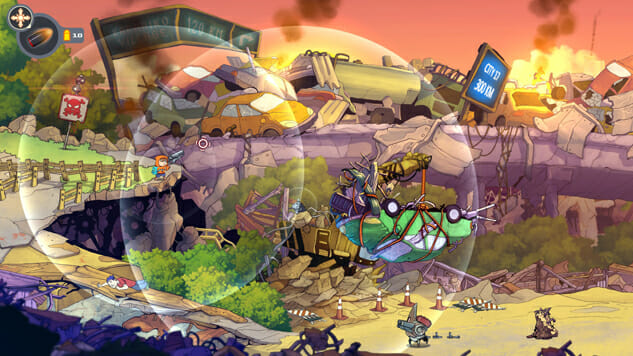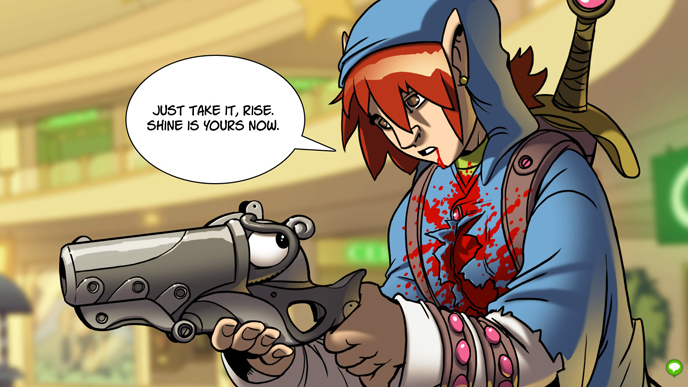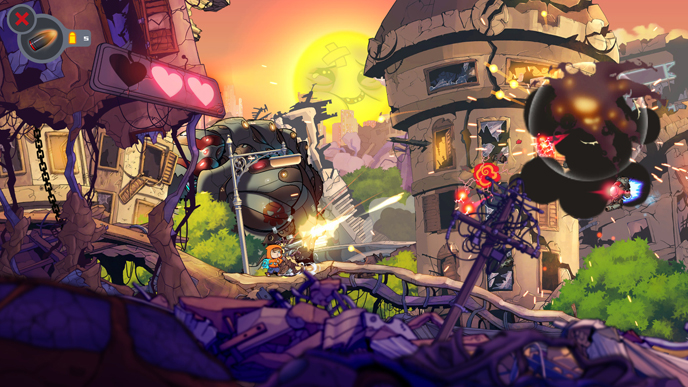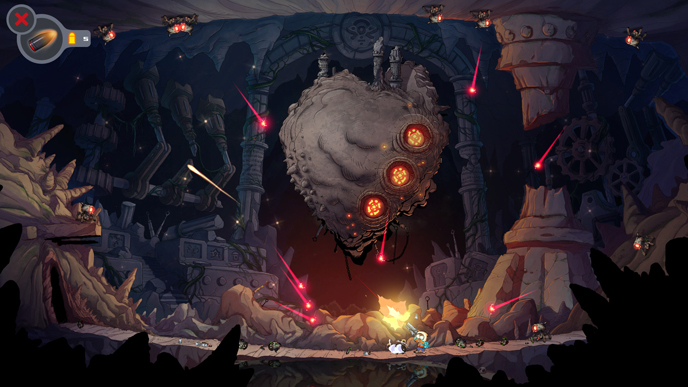
Rise & Shine is the first PC and console project by Super Awesome Hyper Dimensional Mega Team, a studio created by four friends who had previously worked on Plants vs. Zombies and Worms. The game centers on the journey of a boy named Rise and his trusty magical pistol, Shine, as they battle robotic invaders of their planet, Gamearth.
And that’s about as much as I can tell you about it. My knowledge of the game stops right about there. I did my best to put in a fair amount of time, but between an unclear control scheme, vague objectives, and poor pacing, it failed to maintain my attention.
Working up the motivation to stick with Rise & Shine was difficult from the start. Due to infrequent save spots, I was sent back to the beginning after ragequitting a befuddling enemy encounter, and replaying the sluggish opening level was mind-numbing. Like many indie games (mostly roguelikes) Rise & Shine combines punishing gameplay with high stress repetition. If Rise dies, the level resets to its last enemy encounter, and the player is given another chance to complete it. There are no limits to how many times they can try, and many of the environmental hazards and enemy powers are one-hit kills. Each segment is a deadly if dull process of trial and error.
The technique can be quite satisfying in other games; The Binding of Isaac and Hotline Miami come to mind. While I like to call them “meatgrinders” (in reference to Super Meat Boy), their brutality is likely the echo of early arcade and NES game design, when games were made immensely difficult to either sucker the player out of all their quarters or (in the case of Mega Man) lengthen the game’s playability to justify its asking price. But Rise & Shine lacks the pacing needed to create the tension that holds the drama of those titles together. As a result, the gameplay is unmerciful, but not entertaining.
The pacing isn’t the game’s only issue. Even playing the tutorial made me feel like I must be missing something. The game demanded I play the how-to and familiarize myself with the controls, deeming it a necessity, and yet I found myself presented with weathered videogame staples, like dashing, hopping on platforms, and a traditional cover and aim system. What it lacks in innovation, it attempts to make up for in personality, mostly in the form of videogame pop culture references. In another era I might have appreciated them more, but in 2017 they come off as rejected ideas for Threadless tees.
My response to Rise & Shine reminds me of a Tumblr post Anthony Carboni wrote about games criticism and novelty, discussing how the repetition we encounter as games critics ultimately drives us to seek out the new and different, shifting our priorities and expectations away from that of the general gaming audience. As Carboni says, “Good or bad, weirdness and novelty is where change and growth comes from, which is what a medium needs to survive. Evolve or die, etc. So critics tend to give more love to games that attempt something new, whether it’s great or not. In a medium where most things are the same, clumsy ambition beats perfect mediocrity.” What’s more important in the equation, assessing a game based on its ability to entertain (and thus, acting as a consumer advocate) or evaluating it based on what it achieves for videogames as a whole? Am I even qualified to do the latter?
I recently ran into a critic’s review of a movie I really liked and found myself balking at some of the more negative points of their article. But then it occurred to me that as a critic I may not be entitled to that response. After all these years of reviewing games, I’ve elicited the same reaction from no doubt thousands of people. I understand why the audience becomes defensive when their tastes are questioned. I should be immune to that myself. And yet I’m not.
So why is that? Well, my motivations in watching that movie were completely different than the critic’s. I wanted to be entertained. They wanted to consider the film’s merits in the context of its place within the medium. Going in with the same considerations, perhaps I’d have made the same observations. But whatever the case, I realize that now, having seen as much as I have in 8 years, I lack the unseasoned set of eyes needed to enjoy Rise & Shine.
Rise & Shine has all the markers of a hit indie game. The gun’s add-ons, a series of upgrades that include a special curve-the-bullet ability, give the game an individualistic “hook”, and the art style is funky and appealing. If you approach it with the expectation of being entertained, you probably will be. But if you’re looking for a game that will reinvigorate your passion for the innovation of the indie game scene, look elsewhere.
Rise & Shine was developed by Super Awesome Hyper Dimensional Mega Team and published by Adult Swim. Our review is based on the PC version. It is also available for Xbox One.
Holly Green is a reporter, editor, and semiprofessional photographer living in Seattle, WA. She is also the author of Fry Scores: An Unofficial Guide To Video Game Grub. You can find her work at Gamasutra, Polygon, Unwinnable, and other videogame news publications.


